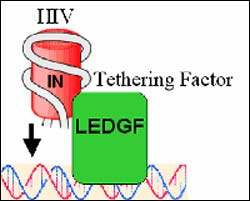HIV inserts into human genome using a DNA-associated protein

LEDGF, a human DNA-associated protein, is the first example of a cellular protein controlling the location of HIV integration in human cells. The red cylinder is an HIV integration complex. The green box is LEDGF, acting as a tether by binding to both HIV integrase and a cellular chromosome. (Credit: Frederic Bushman, PhD, University of Pennsylvania School of Medicine)
Findings have implications for better-designed gene therapies
A human DNA-associated protein called LEDGF is the first such molecule found to control the location of HIV integration in human cells, according to a new study from researchers at the University of Pennsylvania School of Medicine. This study, published in this week’s early online edition of Nature Medicine, describes the first clear target for modulating where viruses insert into the human genome, which has implications for better design of gene-therapy delivery. Retroviral vectors are often used to introduce therapeutic genetic sequences into human chromosomes, such as in the delivery of Factor VIII for hemophilia patients.
HIV integrates into active transcription units on chromosomes within the nucleus of human cells. These units are sites that lead to efficient expression of the viral genome. Most HIV-infected cells in a patient will have a very short life span, a day or less. “We surmise that this strategy helps the virus make hay while the sun is shining, as it were, producing lots of viral copies during a short time, so that the virus can maximize production of daughter virions,” says Frederic Bushman, PhD, Professor of Microbiology at Penn.
This present study demonstrates the first piece of a mechanism that dictates where HIV integration takes place. Previous studies at other institutions showed that LEDGF binds tightly to HIV integrase, the enzyme that’s important for the integration reaction. Now, Penn researchers showed in this study that the way LEDGF binds to HIV integrase and to specific sites on chromosomes suggests that HIV targets integration using a molecular tether.
Retroviruses contain RNA in their particles. They enter a cell and convert RNA into DNA by the enzyme reverse transcriptase and then integrate that DNA copy into the DNA of the host, using the integrase enzyme. The new viral particles are made by transcription of the viral genome, as with any cellular genes. If the cell divides, the viral DNA is copied and inherited, along with cellular human genes.
Bushman and his team made cells that were depleted of LEDGF and found that integration was less frequent in transcription units and in genes regulated by LEDGF. “This implies that LEDGF is part of the machinery that helps dictate the placement of retroviral integration sites within chromosomes,” says Bushman.
Bushman notes that finding that LEDGF is part of the cellular apparatus necessary for HIV replication is important to the field of gene therapy. Controlling where gene-therapy vehicles insert in the human genome could help make the delivery of new therapeutic sequences safer. The new findings about LEDGF suggest that engineered tethering interactions might some day allow control over integration site selection during gene therapy. According to Bushman, this finding is of particular importance in light of recent cases where integration of gene-therapy vectors near cancer genes contributed to the development of leukemia in gene-therapy patients.
“This is first example of a cellular factor that’s a clear player in target site selection,” says Bushman. “This isn’t engineering yet, but it’s a key piece of information on the way.”
Media Contact
More Information:
http://www.uphs.upenn.edu/newsAll latest news from the category: Life Sciences and Chemistry
Articles and reports from the Life Sciences and chemistry area deal with applied and basic research into modern biology, chemistry and human medicine.
Valuable information can be found on a range of life sciences fields including bacteriology, biochemistry, bionics, bioinformatics, biophysics, biotechnology, genetics, geobotany, human biology, marine biology, microbiology, molecular biology, cellular biology, zoology, bioinorganic chemistry, microchemistry and environmental chemistry.
Newest articles

Silicon Carbide Innovation Alliance to drive industrial-scale semiconductor work
Known for its ability to withstand extreme environments and high voltages, silicon carbide (SiC) is a semiconducting material made up of silicon and carbon atoms arranged into crystals that is…

New SPECT/CT technique shows impressive biomarker identification
…offers increased access for prostate cancer patients. A novel SPECT/CT acquisition method can accurately detect radiopharmaceutical biodistribution in a convenient manner for prostate cancer patients, opening the door for more…

How 3D printers can give robots a soft touch
Soft skin coverings and touch sensors have emerged as a promising feature for robots that are both safer and more intuitive for human interaction, but they are expensive and difficult…





















